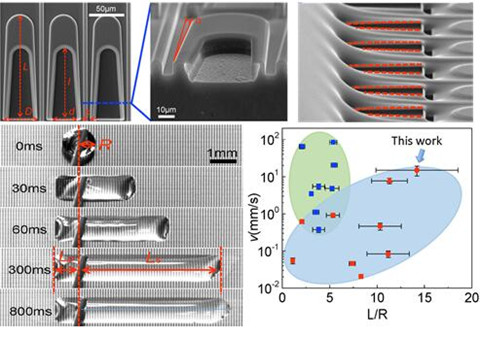

Directed and spontaneous transport of a liquid on a solid surface is highly desired in various settings that range from microfluidics, printing, and oil-water separation to water harvesting technologies. Despite commendable progress, it remains a daunting undertaking to mimic the structural and the functional sophistication inherent in living organisms in a facile and reproducible manner. Recently, the Shanghai Institute of Microsystem and Information Technology (SIMIT), the Chinese Academy of Sciences, in collaboration with City University of Hong Kong (CityU), the China University of Petroleum (East China), Northumbria University and Lehigh University made a breakthrough in the field of bionic liquid-transport surfaces. The research was published in Science Advances (Vol. 3, no. 10, eaao3530,http://advances.sciencemag.org/content/3/10/eaao3530) on Oct 27.

The research reports a new method of microscopic liquid transport based on a unique topological structure. The method breaks the contact line pinning through efficient conversion of excess surface energy to kinetic energy at the advancing edge of the droplet while simultaneously arresting the reverse motion of the droplet via strong pinning. The study reveals the intrinsic mechanism of directional liquid-transport on functional surface structure, and realizes a novel topological liquid diode that allows for a rapid, directional, and long-distance transport of virtually any kind of liquid without the need of external energy input. And the ease of fabrication, generality, and intriguing transport performances of the reported topological liquid diode will open up new avenues to tailor advanced microstructures for self-propelled liquid manipulation in a variety of applications, including water harvesting, heat management, ink-jet printing, and emulsion separation. This research has opened up a new theoretical orientation and technical foundation for the design and manufacture of micro/nano functional surfaces.
Dr. Zhou Xiaofeng from the Shanghai Institute of Microsystem and Information Technology (SIMIT) of the Chinese Academy of Sciences and PhD student Li Jiaqian from City University of Hong Kong (CityU) are the co-first authors; Associate Prof. Wang Zuankai form CityU and Prof. Manoj K. Chaudhury from Lehigh University are the corresponding authors.
For more information, please contact:
Prof. Wang Zuankai
City University of Hong Kong
E-mail: zuanwang@cityu.edu.hk
Prof. Manoj K. Chaudhury
Lehigh University, USA
E-mail: mkc4@lehigh.edu
Dr. Zhou Xiaofeng
Institute of Microsystem and Information Technology, CAS
E-mail: zhouxiaofeng@mail.sim.ac.cn
Source: Institute of Microsystem and Information Technology, CAS